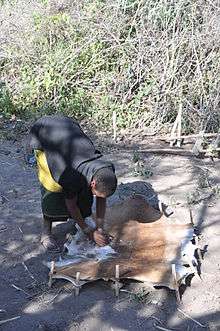Datooga people
The Datooga, known as the Mang'ati in Swahili, are a pastoralist Nilotic people of Manyara Region, Arusha Region, Mara Region, and Singida Region of Tanzania. In 2000 the Datooga population was estimated to number 87,978.[1]
History

Origins
Linguistic evidence points to the eastern Middle Nile Basin south of the Abbai River, as the nursery of the Nilotic languages. That is to say south-east of present-day Khartoum.[2]
It is thought that beginning in the second millennium B.C., particular Nilotic speaking communities began to move southward into present-day South Sudan where most settled and that the societies today referred to as the Southern Nilotes pushed further on, reaching what is present-day north-eastern Uganda by 1000 B.C.[2]
Linguist Christopher Ehret proposes that between 1000 and 700 BC, the Southern Nilotic speaking communities, who kept domestic stock and possibly cultivated sorghum and finger millet,[3] lived next to an Eastern Cushitic speaking community with whom they had significant cultural interaction. The general location of this point of cultural exchange being somewhere near the common border between Sudan, Uganda, Kenya, and Ethiopia.
He suggests that the cultural exchange perceived in borrowed loan words, adoption of the practice of circumcision and the cyclical system of age-set organisation dates to this period.[4]
Linguist Christopher Ehret suggests that around the fifth and sixth centuries BC, the speakers of the Southern Nilotic languages split into two major divisions - the proto-Kalenjin and the proto-Datooga. The former took shape among those residing to the north of the Mau range while the latter took shape among sections that moved into the Mara and Loita plains south of the western highlands.[5]
Recent History
There are at least seven Datooga tribes:
- Bajuta
- Gisamjanga (Kisamajeng, Gisamjang)
- Barabayiiga (Barabaig, Barabayga, Barabaik, Barbaig)
- Asimjeeg (Tsimajeega, Isimijeega)
- Rootigaanga (Rotigenga, Rotigeenga)
- Buraadiiga (Buradiga, Bureadiga)
- Bianjiida (Biyanjiida, Utatu)
The dialects of the Datooga language are often divergent enough to make comprehension difficult, though Barabayiiga and Gisamjanga are very close. The Datooga have interacted with neighboring ethnic groups since at least the 19th century, and the Datooga leader Saigilo is widely known throughout region.
References
- Ehret, Christopher. An African Classical Age: Eastern & Southern Africa in World History 1000 B.C. to A.D.400. University of Virginia, 1998, p.7
- Clark, J., & Brandt, St, From Hunters to Farmers: The Causes and Consequences of Food Production in Africa. University of California Press, 1984, p.234
- Ehret, Christopher. An African Classical Age: Eastern & Southern Africa in World History 1000 B.C. to A.D. 400. University of Virginia, 1998, pp.161–164
- Ehret, C., History and the Testimony of Language, p.118